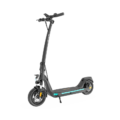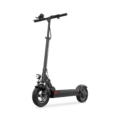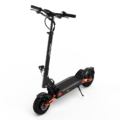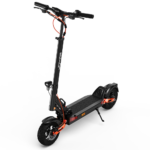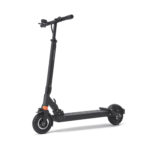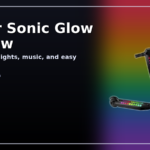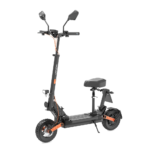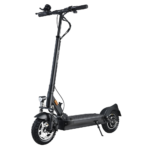- Home
- Scooters
- Electric Scooters
- JOYOR S-PRO DGT
JOYOR S-PRO DGT
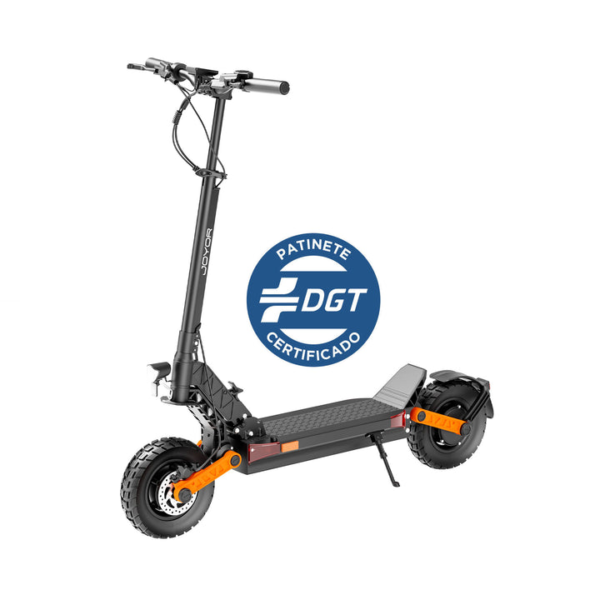

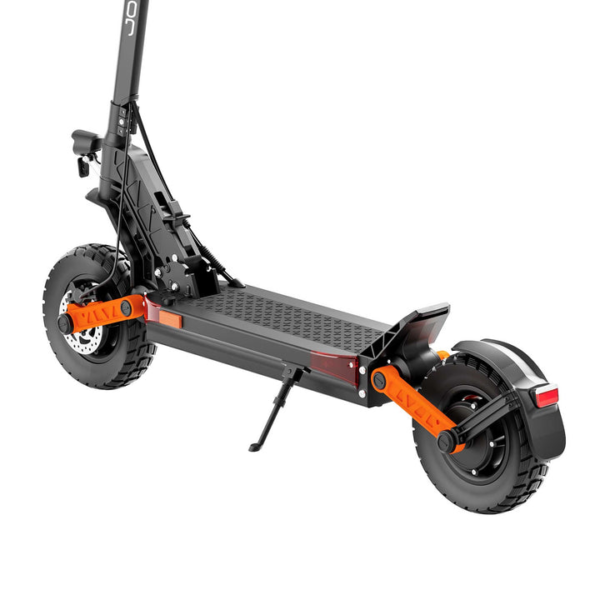

- Battery Range: 28–34 mi (45–55 km)
- Top Speed: 15.5–18.6 mph (25–30 km/h)
- Motor Power: 500 W nominal
- Weight Capacity: 242 lb (110 kg)
- Charging Time: ~6–7 h
- Scooter Weight: 35.3 lb (16.0 kg)
PROS
- DGT-minded speed/lighting package
- Strong city range in compact frame
- Predictable dual-brake control
- Bright, legible display
- Fast, secure folding latch
CONS
- Speed limited by regulation
- Pneumatics require pressure care
- Heavier than ultralights
- Range dips in winter

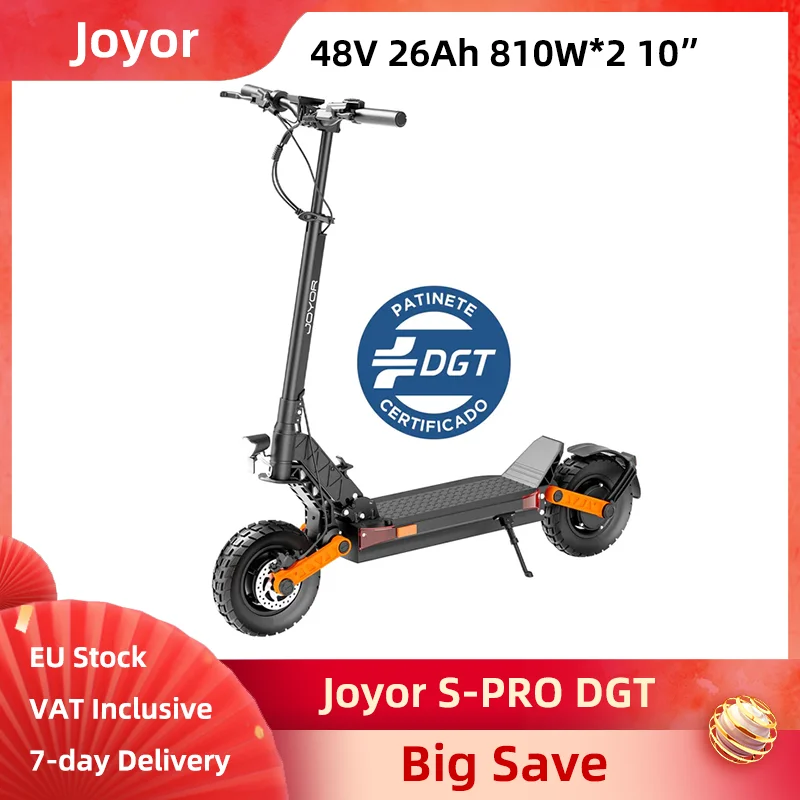
Table of contents
- What Is the JOYOR S-PRO DGT?
- How the JOYOR S-PRO DGT Works
- Key Specifications
- Design & Build Quality
- Performance Fundamentals
- Battery, Range & Efficiency
- Ride Quality & Comfort
- Braking & Safety Features
- Portability & Daily Usability
- Maintenance & Care
- Weather & Seasonal Considerations
- JOYOR S-PRO DGT vs Alternatives
- Who the JOYOR S-PRO DGT Is (and Isn’t) For
- FAQs
- Glossary
- Final Thoughts
The JOYOR S-PRO DGT is a city-friendly electric scooter built for practical commuting and dependable daily use. It blends a robust frame with balanced power and thoughtful safety features. If you want a commuter that feels stable, rides comfortably on real roads, and stays easy to live with, the JOYOR S-PRO DGT hits a sensible sweet spot for many riders.
It suits students, downtown professionals, and anyone who needs a reliable last-mile machine. Moreover, because it puts control and predictability first, the JOYOR S-PRO DGT rewards calm, confident riding rather than headline numbers.
What Is the JOYOR S-PRO DGT?
At its core, the JOYOR S-PRO DGT is a mid-class urban scooter designed to meet modern city rules and real-world needs. The name hints at urban compliance and dependable road manners. You get a brushless hub motor, a lithium-ion battery pack, and a folding aluminum chassis that fits under a desk or slides into a small trunk. Most riders will feel at home within minutes.
Unlike extreme performance models, the JOYOR S-PRO DGT emphasizes composure over flash. While some scooters chase maximum torque or long-range bragging rights, this one focuses on consistent throttle control, predictable braking, and a ride that stays comfortable on mixed pavement. Consequently, it suits stop-and-go traffic, curb cuts, and patchy asphalt far better than many sporty alternatives.
In daily terms, the JOYOR S-PRO DGT behaves like a compact electric “city bike” without pedals. You push off, squeeze the throttle, and cruise at a steady pace. Additionally, you can carry it up a flight of stairs, stow it by your desk, and roll out again at lunch. In short, it embraces practical, everyday tasks and does them well.
How the JOYOR S-PRO DGT Works
The mechanics are simple once you understand the pieces. Think of the system like a quiet, electric moped scaled down for sidewalks and bike lanes.
Motor (hub drive). A brushless hub motor sits inside one wheel. When you squeeze the throttle, the controller sends current to that motor. The wheel turns without chains or belts, so the system stays quiet and low-maintenance. On the JOYOR S-PRO DGT, that smooth, direct drive helps with gentle starts and steady cruising. Furthermore, the sealed hub resists grime better than exposed drivetrains.
Controller (the “brain”). The controller is a small box of electronics that meters power flow. It listens to the throttle and safety sensors, then decides how much current to feed the motor. Imagine a careful bartender pouring just the right amount—no sloshing. As a result, the JOYOR S-PRO DGT delivers predictable acceleration in each ride mode.
Battery (the “tank”). A lithium-ion pack stores energy. Capacity and voltage define how lively the scooter feels and how far it goes. The pack includes protections for over-charge, over-discharge, short circuit, and temperature. Because of that protection, the battery endures daily charging with fewer surprises.
Throttle (your input). A thumb or twist throttle sends a signal that ranges from “just a nudge” to “let’s go.” The JOYOR S-PRO DGT maps throttle response to ride modes, so you can pick calmer or quicker behavior. Many riders start in an Eco-style mode, then move up once they know the route. Meanwhile, the upper modes keep enough restraint to maintain stability.
Brakes (your safety net). Mechanical discs, drums, and electronic regen are all common scooter solutions. The JOYOR S-PRO DGT uses a simple system that favors a clean lever feel and confident stopping. Because urban riding includes abrupt stops, brake consistency matters more than raw power alone. Therefore, the tuning aims for smooth modulation rather than grabby bite.
Key Specifications
Below is a clean, high-level table that captures the core specifications. Because regional packages can vary, treat this as a practical overview rather than a rigid, universal sheet.
| Category | Details |
|---|---|
| General | Urban electric kick scooter; aluminum alloy frame; integrated cockpit display; folding stem; typically 10-inch class wheels; ergonomic grips; rear fender with kickstand. |
| Performance & Power | Brushless hub motor tuned for city speeds; multi-mode power delivery for calm or brisk starts; stable cruising; confident control at commuting pace; suitable for moderate grades with rider-weight awareness. |
| Battery, Charging & Electrical | Lithium-ion battery with balanced capacity; integrated BMS for cell protection; standard portable charger; sealed charge port; onboard display for speed and battery status. |
| Build & Dimensions | Mid-weight chassis for stability; deck sized for natural stance with room to shift feet; compact fold to fit under a desk or into small car trunks. Folded dimensions: compact, carry-on style footprint typical of mid-class commuters. |
| Safety & Control | Dual-action braking system (mechanical plus electronic assist, depending on configuration); bright headlight; tail/brake light; side reflectors; grippy deck; audible bell; intuitive ride modes. |
| Features & Extras | Cruise control commonly available; walking/push assist in low-speed mode on many units; safety latch for the folding joint; anti-slip deck surface; optional app support may vary by region. |
| Warranty & Compliance | Warranty terms vary by seller and region; compliance features and speed caps aligned with local rules; regional certifications typically included on the product label. |
This table gives you the essentials without drowning you in jargon. It reflects how the scooter behaves on real streets and how it fits into daily routines.
Design & Build Quality
The JOYOR S-PRO DGT feels purpose-built for city duty. The frame uses aluminum alloy tubing for a strong, corrosion-resistant structure. The deck sits low enough for easy foot placement yet high enough to clear common bumps. You stand with a natural stance: one foot forward, one slightly back, knees soft. Because the center of gravity sits near your ankles, balance comes quickly.
The stem locks with a positive latch that resists play. That latch matters, because stem wiggle can sap confidence. On the JOYOR S-PRO DGT, the hinge mechanism aims for quick folding and solid upright feel. After a week of daily folding, you will know the motion by muscle memory. In addition, the safety catch reduces the chance of accidental collapse.
Cables route along the stem with tidy guides, and the cockpit stays clean. You glance down to a readable display with speed, mode, and battery. The thumb controls sit within easy reach. Grips feel firm without harsh edges. The brake levers offer a predictable pull, with enough range for feathering or a strong squeeze. Consequently, the cockpit remains friendly for new riders.
Fit-and-finish leans practical. You get a matte paint finish that hides scuffs and wipes clean. The deck’s top layer grips shoes in both dry and damp weather. The rear fender stays firm under regular use and helps guard against spray. Fasteners use common heads, so home maintenance stays straightforward. Furthermore, the overall layout accepts small accessories like bells or auxiliary lights without clutter.
Performance Fundamentals
Because city riding rewards control, the JOYOR S-PRO DGT focuses on smooth, progressive power. Off the line, the scooter eases into motion without a jump. You can feed in throttle and settle the balance with your knees. That makes crosswalk starts less stressful. Additionally, the stable steering geometry keeps the front end calm even during quick lane changes.
Acceleration feels steady. You sense a gentle push at low speed, followed by a calmer rise as you approach cruising pace. The motor’s tuning aims to keep the front end composed and the rear wheel hooked up on painted lines or smooth tile. When the surface changes, the scooter keeps a level attitude rather than pitching or hunting. As a result, confidence builds quickly.
On mild hills, the JOYOR S-PRO DGT climbs best with a small rolling start. Grades near 7–10% ask more from any mid-class commuter, so rider weight and tire pressure matter. If you keep momentum, the scooter handles those slopes for typical city blocks. If a hill gets steeper or longer, shorten your throttle pulses and let the controller breathe. Meanwhile, stand slightly taller to open your chest and keep breathing smooth.
Stability at speed is a highlight. The steering feels direct without twitch. A moderate handlebar width helps your shoulders relax. You can glance over a shoulder, check traffic, and return to center without a wobble. As the pavement shifts from smooth to patchy, the chassis tracks in a straight line. Nevertheless, always scan for seams and metal plates, since those surfaces reduce grip when wet.
Battery, Range & Efficiency
Real-world range depends on rider weight, wind, temperature, hills, and tire pressure. The JOYOR S-PRO DGT responds like most practical commuters: ride gently and you’ll see more miles; ride hard and range shrinks. Because city routes include frequent stops, your throttle habits matter as much as terrain. Therefore, smooth inputs pay off.
Think in tiers:
- Efficiency mode: Lower top speed, gentle throttle, steady cadence. You keep momentum and avoid full-power launches. This style stretches range and reduces heat. Additionally, it eases wear on tires and brakes.
- Balanced mode: Normal city pace with occasional bursts. You trade a little range for time savings. For many riders, this mode feels “just right” day to day.
- Fast mode: Frequent full-throttle pulls and high cruising speed. Fun and brisk, but it eats battery. Consequently, charging becomes more frequent.
Temperature plays a big role. Cold weather reduces available energy and increases internal resistance. Expect a noticeable drop during winter. Heat does the opposite: power feels lively, but prolonged high temperatures can age cells faster. The battery management system protects against extremes; even so, common-sense habits still help.
Charging best practices:
- Use the stock charger on a stable outlet.
- Keep the charge port dry and capped.
- Avoid full charges when storing long-term; 40–60% is kinder to cells.
- Let the pack rest after heavy rides before charging.
- Coil the cable loosely; keep the brick ventilated.
With consistent habits, the JOYOR S-PRO DGT maintains steady range through the workweek. Most riders fall into a rhythm: charge at home, top up at work only when needed, and keep the charger in a desk drawer. Finally, schedule a periodic “balance charge” to keep cell groups aligned.
Ride Quality & Comfort
Comfort starts with tires and stance. The JOYOR S-PRO DGT typically uses 10-inch class wheels, which help smooth out cracks and seams. Many versions use pneumatic tires, which add a forgiving air cushion. If your unit includes suspension, it will further calm sharp hits from brick or cobblestone. Consequently, longer rides feel less fatiguing.
Tire pressure matters. Slightly lower pressures increase comfort and grip, especially on slick paint or wet leaves. However, going too low invites pinch flats on pneumatic tires. Start near the middle of the recommended range, then tune by feel. Check pressure weekly; many “mystery” rattles vanish after a top-off. Similarly, keep valve caps tight to block dust.
Ergonomics suit longer rides. The deck allows a natural staggered stance with room to switch feet. Bar height works for a wide range of riders. If you are taller, a relaxed elbow bend helps with shock absorption. Stem flex stays in check, so you won’t feel a vague hinge during quick lane changes. As a result, straight-line tracking stays calm even over patchy asphalt.
Noise stays low. The hub motor hums under load, and the drivetrain has no chain clatter. On smooth surfaces, wind noise may become the loudest factor. That quiet ride makes early mornings more pleasant and keeps you aware of surrounding traffic. Additionally, low noise reduces attention from pedestrians in shared spaces.
Braking & Safety Features
Brakes must feel predictable, not grabby. The JOYOR S-PRO DGT aims for steady lever travel with a clear bite point. You squeeze, the pads engage, and speed drops in a controlled arc. On dry pavement, you can modulate easily. In the wet, braking distance increases, so plan ahead and keep both hands ready. Therefore, practice gentle rear-bias braking before you need it.
Electronic regen may complement the mechanical system. Light regen helps settle the chassis as you roll off the throttle. Think of it as engine braking in a car. It recovers a bit of energy and smooths transitions. Some riders prefer regen for gentle speed control on long paths. However, still rely on mechanical brakes for hard stops.
Lighting is strong enough for city speeds. A forward headlight marks your path and your presence. The tail light brightens during braking. Side reflectors increase side-on visibility at intersections. Even so, reflective clothing and a brighter auxiliary light help a lot. Importantly, aim the headlight slightly downward to avoid dazzling others.
Water protection helps with surprise showers. Expect splash resistance rather than deep-water survivability. Avoid standing water, rinse the scooter only with a damp cloth, and dry the charge port area after wet rides. The frame and deck handle spray, but electronics prefer dry storage. Consequently, long-term reliability improves when you keep moisture out.
Portability & Daily Usability
Portability can decide whether you ride every day. The JOYOR S-PRO DGT folds quickly with a latch that you can operate in gloves. The stem tucks down, the scooter compacts, and you can lift it in one hand for short distances. For long hauls through a station, carry with both hands at the balance point or roll it slowly by the stem. Meanwhile, keep fingers clear of the hinge.
The weight feels manageable for a mid-class commuter. You can lift it into a trunk or up a short set of stairs. On crowded buses or trains, the compact fold reduces the footprint to passenger-friendly size. The deck and rear fender survive daily bumps with doors, benches, and curbs. Additionally, the kickstand is sturdy enough for quick coffee stops.
Storage needs are modest. A corner of an office or a closet at home works fine. Keep it off damp floors and out of direct sun. If you park in a garage, use a cover to block dust. For security, use a solid lock through the frame or a hardened loop. Pair that with a visible deterrent like a cable for the wheel. Nevertheless, bring the scooter indoors overnight when possible.
Day to day, the JOYOR S-PRO DGT feels easy to live with. You fold, roll, ride, and repeat. The rituals become quick and satisfying. Consequently, consistency builds the habit, and the commute becomes something you actually enjoy.
Maintenance & Care
A simple schedule keeps the JOYOR S-PRO DGT reliable and quiet.
Before each ride (30 seconds):
- Squeeze brakes; confirm firm lever feel.
- Check the tires for cuts and adequate pressure.
- Confirm the latch locks with no play.
- Tap the bell; test the lights.
Weekly (10–15 minutes):
- Top up tire pressure.
- Wipe the deck and stem; look for loose fasteners.
- Inspect brake pads for even wear.
- Check cables for fray or pinch points.
- Listen for new rattles; trace them now, not later.
Monthly (20–30 minutes):
- Re-torque key bolts on the stem, folding hinge, and wheel hardware.
- Clean the brake rotors or drum area with an appropriate cleaner.
- Inspect the tires for embedded debris.
- Update firmware if your configuration supports an app and updates are available.
- Condition the battery with a balanced charge cycle.
Seasonal (as needed):
- Deep-clean the frame and under-deck shielding.
- Refresh grip tape if worn smooth.
- Replace pads and tires before they pass minimum wear.
- Check the folding latch alignment and safety catch function.
Because the JOYOR S-PRO DGT uses a hub motor and a simple drivetrain, you avoid chain lube and derailleur tuning. That keeps maintenance approachable for beginners. Furthermore, parts access is straightforward compared with complex dual-motor machines.
Weather & Seasonal Considerations
Weather affects range, traction, and comfort. Plan for it, and the JOYOR S-PRO DGT remains a trustworthy partner.
Rain. Wet roads reduce grip and extend stopping distances. Reduce speed, brake earlier, and avoid leaning hard on painted lines or metal plates. Wipe the scooter dry after the ride, especially near the charge port and folding hinge. Keep the deck clear of grit so your shoes stay planted. Additionally, consider slightly lower tire pressure for better wet traction within the safe range.
Cold. Battery chemistry slows in the cold, so range drops. Pre-warm the scooter indoors before riding. Store the battery above freezing when you can. Dress for wind chill; cold hands react slower at the levers. Therefore, use gloves with good tactile feel.
Heat. High temperatures make the scooter feel lively but can stress components if pushed hard. Park in the shade, avoid leaving the scooter in a hot car, and let the battery cool before charging. As a result, long-term battery health improves.
Wind. Headwinds cut range. Tailwinds stretch it. On gusty days, keep your knees bent and elbows soft. The JOYOR S-PRO DGT remains composed if you ride loose and centered. Nevertheless, avoid high-sided clothing that catches crosswinds.
Debris and seasonal hazards. Autumn leaves and spring sand pose slip risks. Roll straight over them and avoid sharp throttle inputs. After storms, watch for branches, nails, and glass. In addition, check tires after each messy ride.
JOYOR S-PRO DGT vs Alternatives
Electric scooters fall into rough groups: lightweight last-mile models, balanced commuters like this one, long-range tourers, and high-power performance machines.
Where the JOYOR S-PRO DGT excels
- Urban balance: It offers steady acceleration, predictable braking, and a calm steering feel at commuting speeds.
- Daily practicality: It folds quickly, carries reasonably, and stores easily.
- Low noise, low fuss: The hub motor keeps things quiet, and the simple drivetrain reduces maintenance.
- Confidence for new riders: The controls feel intuitive, and the chassis doesn’t surprise you.
Where a different class could be better
- Steep, sustained hills: Performance models with higher torque climb faster and stay cooler.
- Very long routes without charging: Long-range tourers carry larger battery packs.
- Ultra-light carry needs: If you climb many flights of stairs, a lighter last-mile scooter saves your back.
- Off-road adventures: Trail-focused scooters use bigger suspension and heavy-duty tires.
- Step-up alternative: For riders who want a stronger, sportier Joyor with more headroom, consider the JOYOR S10-S-Z as a next-tier option.
Consequently, if your life is mostly city blocks, mixed pavement, and predictable commutes, this model lands in a practical sweet spot. However, if your route is hilly or very long, consider a class tuned for torque or range.
Who the JOYOR S-PRO DGT Is (and Isn’t) For
Ideal for:
- Commuters who want reliable, repeatable rides at calm city speeds.
- Students moving between classes and transit stops.
- Multi-modal travelers who fold, carry, and hop on a train twice a day.
- New riders who value stability and forgiving controls.
- Daily riders who prefer a quiet, tidy machine that just works.
Not ideal for:
- Steep-hill residents who want brisk climbs with no momentum.
- Speed-seekers who want high-velocity thrills.
- Heavy cargo haulers who plan to strap big loads on the deck.
- Riders craving deep suspension travel for rough trails.
Ultimately, the JOYOR S-PRO DGT thrives when the route matches its strengths: predictable surfaces, frequent stops, and steady pace. Conversely, if you often ride rough trails or carry heavy loads, a different category will serve you better.
FAQs
1) Is the JOYOR S-PRO DGT good for daily commuting?
Yes. It folds fast, rides quietly, and feels stable at typical city speeds. The control layout suits repeated stop-and-go trips. Additionally, the braking system remains predictable in varied conditions.
2) How does the scooter handle hills around 7–10%?
It climbs best with a rolling start and sensible throttle. Rider weight and tire pressure matter. On longer or steeper grades, pace your acceleration. Meanwhile, shift your weight forward slightly to keep front-end steering light but planted.
3) What tire setup works best here?
Pneumatic tires offer comfort and grip for most riders. Keep pressures in the recommended range and adjust slightly for comfort or efficiency. However, check pressure weekly to avoid slow leaks.
4) Does it have cruise control?
Cruise control is commonly available. Engage it on straight, clear paths only, and always stay ready on the brakes. Consequently, you can rest your thumb on long, open stretches.
5) What should I know about riding in wet weather?
Reduce speed and brake earlier. Avoid standing water and slick paint. Dry the scooter after rides and keep the charge port capped. Additionally, give yourself more following distance.
6) How often should I service the brakes?
Check lever feel before each ride. Inspect pads monthly. Clean the braking surfaces and re-torque fasteners on a regular schedule. Therefore, small issues stay small.
7) Where can I read a JOYOR S-PRO DGT overview in short form?
You’re reading one now. This JOYOR S-PRO DGT overview covers design, ride feel, safety basics, and care in a concise, no-hype format. In brief, it’s the quick reference you can revisit.
Glossary
- Ah (Amp-hours): Battery capacity measure. Higher Ah usually means more stored energy.
- Wh (Watt-hours): Total energy (volts × amp-hours). A stronger indicator of range than Ah alone.
- Controller: The electronic “brain” that meters current from the battery to the motor.
- Regen (regenerative braking): The motor acts as a generator while slowing, feeding a bit of energy back.
- Stem flex: Slight bending in the steering column under load; too much can feel vague.
- IP rating: Ingress Protection code that describes dust and water resistance levels.
- BMS (Battery Management System): Electronics that protect the battery pack from unsafe conditions.
- Torque: Rotational force from the motor; higher torque helps with starts and hills.
- Ride modes: Preset power maps that change throttle response and top-speed behavior.
- Fold latch: The mechanism that locks the stem upright or releases it for folding.
- Pneumatic tire: Air-filled tire that cushions impacts and improves grip.
- Drum/Disc brake: Enclosed drum or exposed rotor with caliper; both slow the wheel mechanically.
- Thumb throttle: A lever under your right thumb that controls speed.
- Cut-off/limiter: Electronics that enforce regional speed or power limits.
- Wheelbase: Distance between the wheel centers; a key factor for stability.
Final Thoughts
The JOYOR S-PRO DGT is a commuter’s scooter at heart. It prioritizes calm control, useful comfort, and daily convenience. You get smooth starts, steady cruising, and brakes that talk to your fingers, not surprise them. It folds fast, tucks into small spaces, and asks little in return. Moreover, the maintenance routine stays friendly even for first-time owners.
If you want a quiet electric partner that just gets the commute done—day after day—the JOYOR S-PRO DGT deserves a spot on your shortlist. Ride it with soft knees, smart tire pressures, and a gentle hand on the throttle. It will reward you with a confident, low-drama trip every time. Finally, keep up with simple checks, and the experience remains smooth for seasons to come.
Specifications
General
| Model The Model specifies the exact version or name of the scooter. It helps identify its unique design, features, and specifications within the manufacturer’s product line. Knowing the model makes it easier to compare options, find compatible accessories, or look up support information. | S-PRO DGT |
| Brand The Brand identifies the manufacturer or company that designs and produces the scooter. A trusted brand is a sign of quality, reliability, and good customer support. Well-known brands often have higher standards for safety, performance, and after-sales service, giving you more confidence in your purchase. | JOYOR |
| Release Date The Release Date indicates when the scooter model was officially launched on the market. This helps you know how current the design, technology, and features are. A newer release date often means updated components, improved performance, and the latest safety or smart features. | 17 November 2025 |
| Recommended Age Recommended Age indicates the minimum age range that the scooter is designed for, based on safety, size, and ease of use. Following the recommended age helps ensure that riders can handle the scooter’s speed, weight, and controls comfortably and safely. Always check local laws and use protective gear, especially for younger riders. | Recommended 16+ |
Performance & Power
| Motor Power (Wattage) What it means: The motor power, measured in watts (W), shows how strong the scooter’s electric motor is. Why it matters: Higher wattage usually means better acceleration, more torque, and improved performance on hills or rough terrain. For example, a 250W motor is good for flat city roads and light riders, while a 500W or 1000W motor provides more power for faster speeds or climbing steep inclines. | 500 W nominal |
| Top Speed The Top Speed indicates the maximum speed that the scooter can reach under optimal conditions. It’s usually measured on level ground with a fully charged battery and an average rider weight. A higher top speed allows you to travel longer distances faster, but always ensure you ride within legal speed limits and your personal comfort zone for safety. | 25–30 km/h |
| Battery Capacity Battery Capacity refers to the total amount of energy the scooter’s battery can store, usually measured in ampere-hours (Ah) or watt-hours (Wh). A higher battery capacity means you can ride longer distances on a single charge, reducing the need for frequent recharging. Keep in mind that actual range can vary depending on rider weight, terrain, speed, and weather conditions. | 48 V 13 Ah |
| Estimated Range per Charge The Estimated Range per Charge indicates the average distance the scooter can travel on a single full battery charge. This range is calculated under optimal conditions, such as flat terrain, moderate speed, and average rider weight. Real-world range may vary depending on riding style, terrain, weather, and load. A longer range means fewer recharges and greater freedom for longer trips. | 45–55 km |
| Hill Climb Ability Hill Climb Ability describes the maximum incline or slope that the scooter can handle while maintaining stable performance. It’s typically expressed as a percentage or in degrees. A higher hill climb rating means the scooter can tackle steeper hills without losing too much speed or power. Actual climbing performance may vary based on rider weight, battery charge, and terrain conditions. | Up to 16° grades |
| Drive System The Drive System refers to how power from the motor is delivered to the wheels. Electric scooters typically use either a hub motor (directly integrated into the wheel) or a chain/belt drive system. A high-quality drive system ensures smooth acceleration, efficient power transfer, and low maintenance. The choice of drive system affects performance, noise level, and overall ride experience. | Rear hub motor (RWD) |
Charging & Electrical
| Charging Time Charging Time indicates how long it takes to fully recharge the scooter’s battery from empty to 100% using the standard charger provided. Faster charging means less downtime and more time on the road. Actual charging time may vary slightly depending on battery capacity, charger output, and environmental conditions. | Approx. 6–7 hours |
| Battery Type Battery Type refers to the specific technology used in the scooter’s battery, which affects performance, lifespan, weight, and charging time. Most modern electric scooters use high-quality lithium-ion (Li-ion) batteries because they offer a good balance of energy density, durability, and low maintenance. A reliable battery type ensures consistent power delivery and longer riding ranges. | Li-ion with Smart BMS |
| Removable Battery A Removable Battery means the battery pack can be easily detached from the scooter for convenient charging and replacement. This feature allows you to charge the battery separately, swap it with a spare for extended range, or securely store it indoors in extreme weather. Removable batteries add flexibility and make it easier to keep your scooter powered up wherever you are. | No external fast charge |
| Regenerative Braking Regenerative Braking is an energy-saving feature that converts some of the energy normally lost during braking back into battery power. When you slow down or brake, the motor works in reverse to generate electricity, which helps extend the scooter’s range and improves overall efficiency. This system also reduces wear on traditional brake components, leading to lower maintenance over time. | Front e-brake + rear disc |
| Lighting Lighting refers to the built-in front and rear lights that enhance visibility and safety when riding in low-light conditions or at night. Good lighting helps you see the road ahead and ensures that other road users can see you. Many scooters include LED headlights, taillights, and sometimes brake lights or side reflectors for added safety and compliance with local traffic regulations. | DGT lighting + reflectors + bell |
Build & Dimensions
| Scooter Weight Scooter Weight refers to the total weight of the scooter when fully assembled, including the battery. This affects how easy it is to carry, lift, and store the scooter when not in use. A lighter scooter is more portable and convenient for commuting, especially if you need to carry it upstairs or onto public transport. Keep in mind that a sturdy frame and quality components may add to the weight but also contribute to better durability and ride stability. | 35.3 lb (16.0 kg) |
| Maximum Rider Weight Maximum Rider Weight indicates the highest rider weight that the scooter is designed to safely support while maintaining optimal performance and stability. Staying within this limit helps ensure reliable acceleration, braking, and climbing ability, and it protects the frame, suspension, and motor from excessive strain. Exceeding the recommended limit may reduce performance and increase wear on components. | 242 lb (110 kg) |
| Deck Size Deck Size refers to the dimensions of the scooter’s standing platform. A wider and longer deck provides more foot space, allowing you to stand comfortably and adjust your stance while riding. A well-sized deck improves balance and stability, especially on longer rides or at higher speeds. Compact decks, on the other hand, help keep the scooter lightweight and portable. | Compact deck; planted stance |
| Handlebar Height Handlebar Height refers to the distance from the deck to the handlebars, which affects your riding posture and comfort. An appropriate handlebar height helps you maintain good balance, reduces strain on your back and arms, and makes steering more comfortable. Some scooters have adjustable handlebars to fit riders of different heights, while others have a fixed height for a streamlined design. | Adult fixed bar height |
| Folding Mechanism The Folding Mechanism describes how easily and securely the scooter can be folded for carrying and storage. A well-designed folding system lets you quickly collapse the scooter into a compact size, making it convenient to transport on public transit, store under a desk, or fit into a car trunk. Look for sturdy latches and safety locks to ensure the scooter stays firmly in place when folded or unfolded. | Quick folding latch |
| Dimensions Folded Dimensions indicate the size of the scooter when it’s fully folded. This measurement shows how much space the scooter will take up when stored or carried, making it easier to check if it will fit in your car trunk, under a desk, or in a closet. Compact folded dimensions are ideal for commuters who need to bring their scooter on public transport or store it in tight spaces. | 44.9 × 18.5 × 19.3 in (folded) |
| Material Material refers to the primary construction materials used for the scooter’s frame and key components. High-quality materials like aircraft-grade aluminum, reinforced steel, or durable composites provide strength, stability, and a lighter overall weight. A sturdy material ensures the scooter can handle daily wear and tear while maintaining safety and performance. | Aluminum alloy |
Safety & Control
| Brake Type(s) Brake Type(s) describe the braking systems the scooter uses to help you slow down or stop safely. Common brake types include mechanical brakes (like drum or disc brakes), electronic brakes, and foot brakes. Many scooters combine multiple braking systems for added safety and shorter stopping distances. The type and quality of brakes affect your control, especially when riding at higher speeds or on slopes. | Front e-brake + rear disc |
| Suspension Suspension refers to the system that absorbs shocks and vibrations while riding, providing a smoother and more comfortable ride over uneven or rough surfaces. Scooters may have front suspension, rear suspension, or dual suspension for better shock absorption and stability. Good suspension helps reduce rider fatigue and improves control, especially when riding on bumpy roads or off-road paths. | Front shock |
| Tire Type Tire Type refers to the kind of tires the scooter uses, which directly affects ride comfort, traction, and maintenance. Common types include solid (airless) tires, pneumatic (air-filled) tires, or hybrid options. Pneumatic tires offer better shock absorption and a smoother ride on rough surfaces, while solid tires are puncture-proof and require less upkeep. The right tire type helps ensure safe handling and a comfortable ride in different conditions. | Pneumatic street |
| Tire Size Tire Size indicates the diameter and width of the scooter’s tires, which affect ride comfort, stability, and how well the scooter handles different terrains. Larger tires generally offer better shock absorption and a smoother ride over bumps and rough surfaces, while smaller tires keep the scooter lighter and more portable. Choosing the right tire size helps ensure a balance between agility and comfort. | 10-inch |
| Kickstand The Kickstand is a built-in stand that allows you to park your scooter upright when it’s not in use. A sturdy kickstand keeps the scooter stable and prevents it from tipping over, protecting it from scratches and damage. It also makes storing and accessing your scooter more convenient, whether you’re at home, work, or on the go. | Side kickstand |
| Water Resistance Rating Water Resistance Rating indicates how well the scooter is protected against water and moisture, usually shown as an IP (Ingress Protection) rating. This rating helps you understand whether the scooter can handle light rain, splashes, or wet roads without damage. While most scooters are not fully waterproof, a good water resistance rating adds peace of mind when riding in changing weather conditions. Always avoid deep puddles or submerging the scooter to protect its electrical components. | IPX4 body |
Features & Extras
| Display/Console The Display (or Console) shows important real-time information about your ride, helping you monitor your scooter’s status at a glance. Typical displays show speed, battery level, distance traveled, and riding mode. Some models also include additional features like Bluetooth connectivity, app integration, or backlighting for better visibility at night. A clear and easy-to-read display enhances safety and convenience on every trip. | LCD dashboard |
| Ride Modes Ride Modes refer to the different speed and power settings you can choose to match your riding style or road conditions. Common modes include eco for maximum range and energy efficiency, standard for everyday balance, and sport or turbo for higher speed and stronger acceleration. Switching between ride modes allows you to customize performance, conserve battery, and ride safely in various environments. | Eco, Drive, Sport |
| Smart App Connectivity Smart App Connectivity lets you pair your scooter with a dedicated mobile app via Bluetooth. Using the app, you can monitor real-time ride stats like speed, battery level, and range, adjust settings such as ride modes or cruise control, lock the scooter for added security, and sometimes receive firmware updates. This feature adds convenience and allows you to personalize your riding experience right from your smartphone. | Bluetooth app connectivity |
| Anti-Theft System The Anti-Theft System helps protect your scooter from unauthorized use or theft. This feature can include built-in alarms, electronic motor locks, GPS tracking, or remote locking through a mobile app. A good anti-theft system provides peace of mind when parking your scooter in public spaces, adding an extra layer of security to safeguard your investment. | App lock |
| Cruise Control Cruise Control allows you to maintain a steady speed without continuously holding the throttle. This feature makes longer rides more comfortable by reducing hand fatigue and providing a smoother, more relaxed riding experience — especially on flat, open roads or bike lanes. For safety, cruise control can usually be easily activated or deactivated while riding. | Yes (cruise control) |
| Accessories Included Accessories Included lists the additional items that come with the scooter to enhance your riding experience and convenience. Common accessories may include a charger, kickstand, bell, lights, phone holder, or carrying strap. These extras add value by making your scooter safer, easier to use, and ready to ride straight out of the box. | Bell, reflectors, charger |
Warranty & Compliance
| Warranty Period The Warranty Period indicates how long the manufacturer guarantees the scooter against defects in materials and workmanship under normal use. A good warranty provides peace of mind, showing the brand’s confidence in its product quality. Always check what parts are covered, such as the frame, battery, and motor, and follow the maintenance guidelines to keep your warranty valid. | 12–24 months typical |
| Certifications Certifications confirm that the scooter meets specific safety, quality, and environmental standards set by recognized organizations or regulatory bodies. Common certifications may include CE, RoHS, UL, or other local compliance marks, depending on your region. These certifications ensure that the scooter is manufactured to high standards and is safe and legal to use in your country. | Spanish DGT compliance (category-dependent) |
Price Comparison




